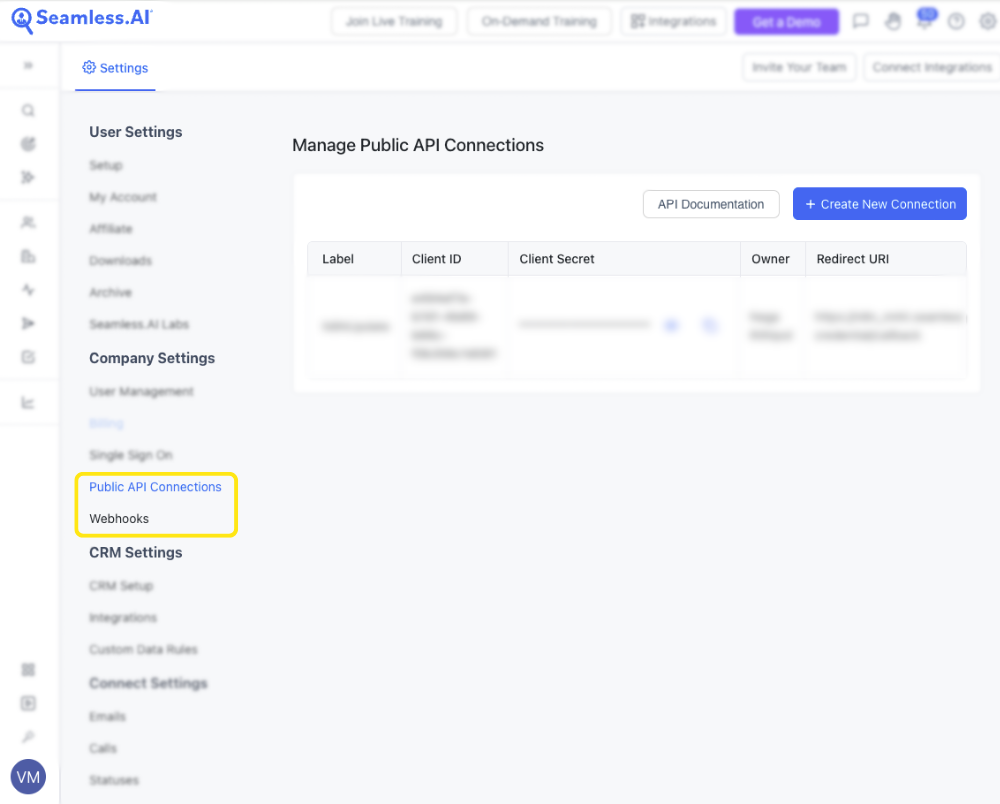What Is the Seamless.AI API?
The Seamless.AI API gives your team direct, programmatic access to our real-time contact and company data—without using the app interface.
With the API, you can:
- Search for leads using filters like job title, company size, industry, and location.
- Enrich incomplete records with verified contact and company details.
- Sync enriched or searched data directly into your CRM or internal systems.
This is ideal for teams looking to scale, automate, and customize their lead workflows using Seamless.AI’s powerful data engine.
Interested in learning more about adding API Credits to your license? Reach out to our sales team here.
Integration Options Overview
The Seamless.AI API supports multiple authentication and integration methods to fit your organization’s needs:
Persistent API Keys
- A long-lived, stable key that eliminates the need for refresh tokens.
- Provides a direct, secure connection to the API using a single key.
- Easy to manage and ideal for integrations with platforms like Salesforce, MCP, and N8N.
- Works as a “plug-and-play” authentication method—recommended for most standard use cases.
OAuth with Refresh Tokens
- OAuth 2.0-based authentication for session-based access.
- Requires regular refreshing of tokens to maintain active connections.
- Useful when tighter control over session lifecycles is desired.
Webhooks
- Event-driven architecture to send real-time updates from Seamless.AI to your systems as they happen.
- Ideal for workflows where immediate action is required, such as integrations like Clay.
These methods can be used individually or in combination. For example, you can run Persistent Keys for steady integrations while using Webhooks for event-based triggers. Persistent Keys work alongside the other methods, with separate limits of up to 25 keys each. Your current OAuth tokens and Webhook configurations remain active and unaffected.
Admin Controls & Visibility
- Organization-Wide Management: Admins can view and manage all API keys created by users in their org.
- User Privacy: Users cannot view or manage each other’s keys.
- Limits: Each method (Persistent Keys and OAuth) supports up to 25 active keys per organization. With the recent addition of 25 Persistent Key slots, organizations effectively have the capacity to run up to 50 requests.
Key Capabilities of the Seamless.AI API
There are many efficient and effective use cases and key capabilities to use the Seamless.AI API Key. Some include:
- Search Contacts & Companies - Build targeted lists programmatically to power internal tools and campaigns.
- Enrich Data - Provide partial inputs and receive enriched, verified records for CRM cleanup and segmentation.
- Sync Data - Automatically deliver enriched or searched data into your CRM, marketing platform, or other internal tools.
- Trigger Actions (Webhooks) - Receive real-time notifications and instantly act on events as they happen.
How to Get Started
Seamless.AI Users with an API License can access, manage, and set up new API Connection in their Settings. Manage and create API connections based on your needs from the “Webhooks” page or “Public API Connections” page under Company Settings.

Step 1: Define Your Use Case
- Decide if you need search, enrichment, sync, or event-triggered workflows.
- Identify the fields and endpoints you’ll use. (e.g., title, phone, company size)
- Estimate your data volume and frequency (real-time vs batch)
Step 2: Set Up the API
- Review our API documentation.
- Choose your preferred integration method(s): Persistent Key, OAuth, and/or Webhooks.
- Obtain your key or configure OAuth and/or Webhook endpoints.
- Work with your development team to connect Seamless.AI to your systems (e.g., Salesforce, HubSpot, Marketo).
Additional API Documentation available here: https://docs.seamless.ai/
Step 3: Launch & Monitor
- Start with a small workflow (like enriching inbound leads).
- Monitor results and validate accuracy.
- Scale into additional use cases (e.g., lead routing, campaign prep, database refresh).
What Data Can Be Returned?
When using the API, you’ll receive a comprehensive set of contact and company data fields:
Contact Details
- Full Name, Title, Department, Seniority
- Primary & Alternate Emails (with validation scores)
- Direct Dials & Mobile Numbers
- Location: City, State, Country, ZIP
Company Details
- Company Name, Website, Domain
- Size, Revenue, Industry, SIC/NAICS Codes
- Headquarters Location, Tech Stack, Founded Date
Metadata & CRM Fields
- Import & Research Dates
- CRM Identifiers for syncing
- Lead Source Metadata
